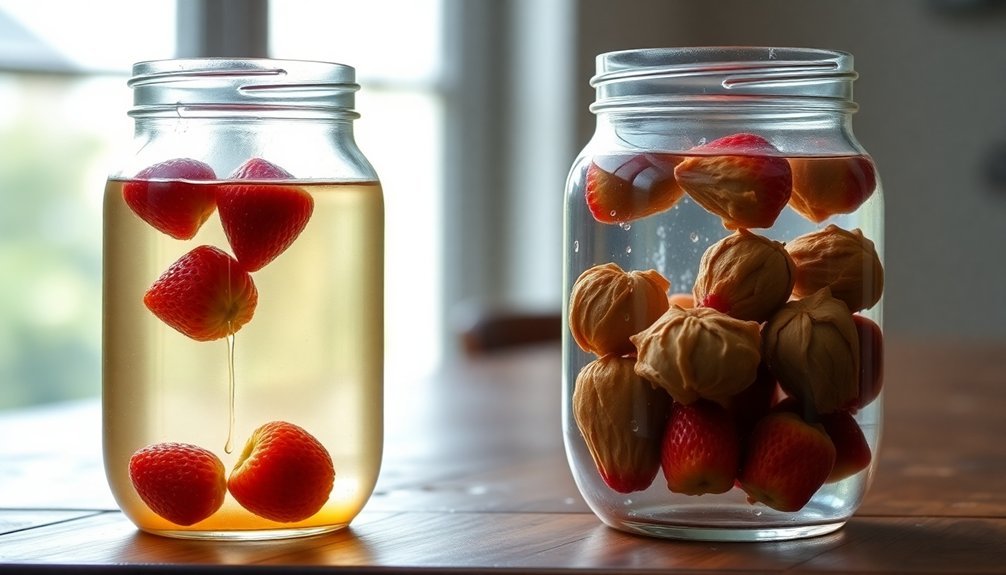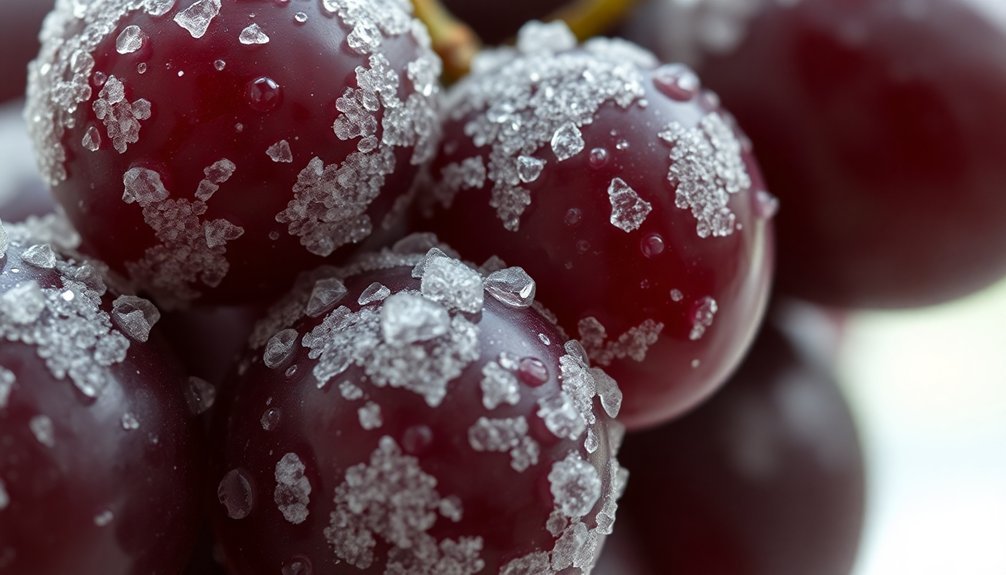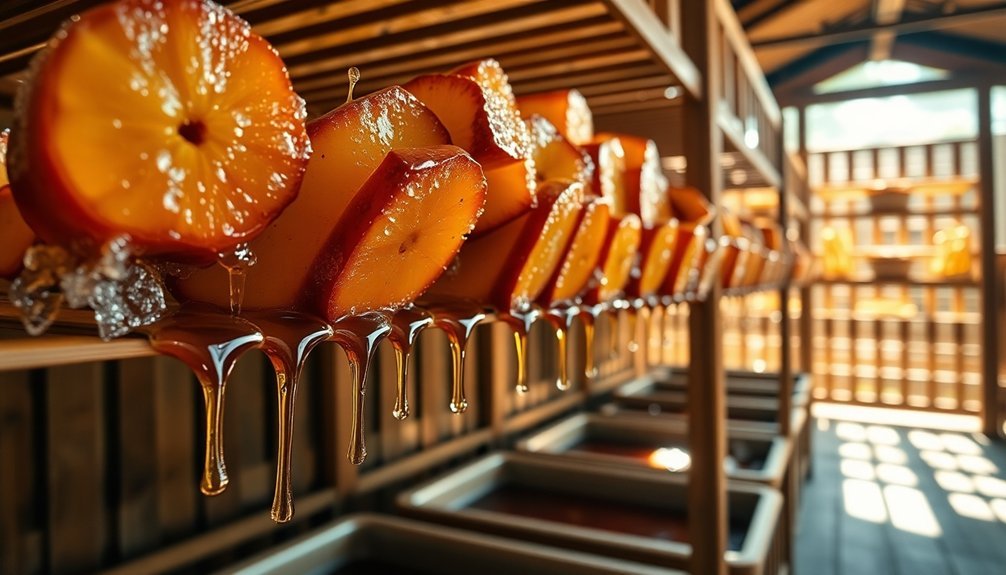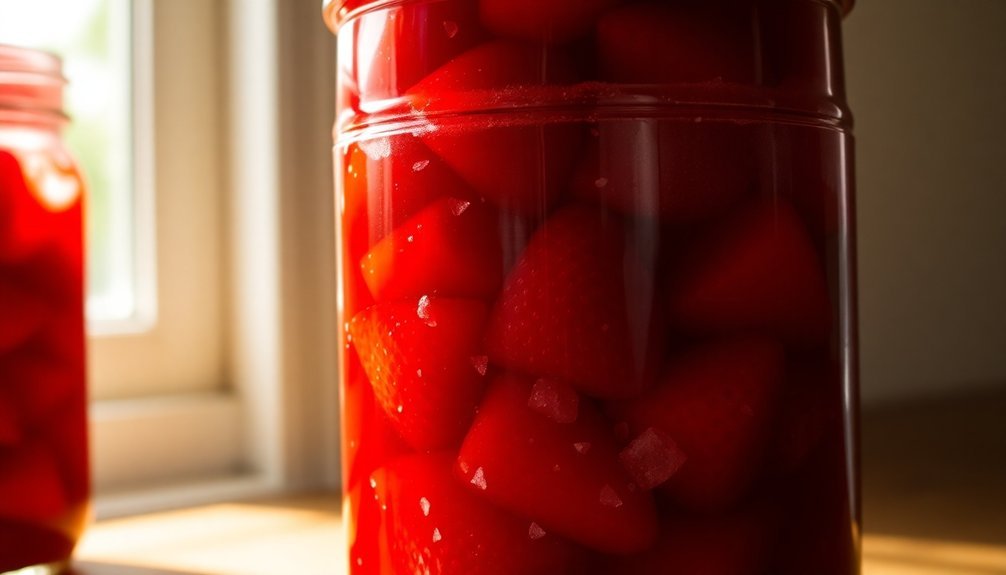Sugar works as a powerful food preservative by drawing moisture away from bacteria and other harmful microorganisms through osmosis. When you add sugar in high concentrations to foods, it creates an environment where bacteria can't survive or multiply. It's like creating a desert-like condition where microbes can't get enough water to function. You'll find this preservation method in jams, jellies, and candied fruits, where sugar concentrations typically range from 10% to 60%. This natural preservative has been keeping foods fresh since ancient times, and there's much more to discover about its remarkable protective properties.
Understanding Sugar's Preservative Power

Nearly every home cook has used sugar as a sweetener, but its remarkable power as a food preservative often goes unnoticed. When you add sugar to foods, it creates an osmotic effect that pulls water away from microorganisms, making it harder for them to survive and multiply. This reduction in water activity is vital for food preservation, as harmful bacteria need moisture to thrive. This preservation technique has been used for centuries to keep foods like jams and jellies safe to eat.
You'll find that sugar works in multiple ways to protect your food. It doesn't just dehydrate harmful microorganisms; it can also facilitate the production of natural preservatives through fermentation. When you're making foods like sauerkraut or yogurt, sugar gets converted into protective substances like lactic acid, while in beverages like wine, it transforms into alcohol – both of which help prevent spoilage.
Different sugars offer varying levels of protection. While high concentrations of glucose, fructose, sucrose, or maltose will inhibit bacterial growth, you'll need to be careful with low concentrations, as they can actually encourage bacterial multiplication.
That's why it's important to use the right amount of sugar when you're preserving foods – there's a specific threshold where sugar switches from being bacterial food to becoming a preservation agent.
Historical Preservation Using Sugar
You'll find that sugar preservation dates back to ancient civilizations, where honey was the primary sweetener used to keep fruits fresh and edible for extended periods.
The Greeks and Romans perfected these methods, with the Romans particularly cooking quince and honey together to create preserved fruits with improved texture. Ancient preservation recipes were first documented in De Re Coquinaria, showcasing early sugar preservation techniques.
The techniques spread throughout Europe through trade routes, leading to widespread adoption of sugar-based preservation methods that continue to influence our modern food preservation practices.
Ancient Sugar Preservation Methods
The ancient practice of food preservation took a sweet turn when early civilizations discovered sugar and honey's remarkable preservative properties. When you look at how these sweeteners work, you'll find they share a significant mechanism: they draw moisture from microorganisms through a process called plasmolysis, effectively killing them by dehydration.
Ancient Greeks and Romans were particularly skilled at using these preservation methods. You'll find that Greeks commonly mixed quince with honey, partially dried the mixture, and stored it in tightly sealed jars. Ice houses were used alongside sugar preservation to maximize food storage options.
The Romans later enhanced this technique by heating the quince-honey combination, creating a firmer texture that would last even longer.
If you lived in northern Europe during the Middle Ages, you'd have relied heavily on sugar preservation, as the weak sunlight made traditional drying methods ineffective.
These regions saw extensive use of sugar cane imported from India and the Orient. You'd have found housewives creating preserves by carefully heating fruit with sugar, achieving concentrations between 10% and 60% depending on the desired outcome.
While sugar wasn't essential for food safety, it played a significant role in maintaining the texture, color, and shape of preserved fruits.
Sugar's Cultural Preservation Legacy
Sugar preservation methods have shaped culinary traditions across diverse cultures for millennia, leaving an enduring legacy that extends far beyond simple food storage. From ancient Greeks and Romans to modern-day practices, you'll find that sugar's role in food preservation has remained remarkably consistent, adapting to different cultural needs and available resources.
When you explore traditional preservation methods, you'll discover that sugar's effectiveness led to its widespread adoption, particularly in regions where sun-drying wasn't practical.
Here's how sugar preservation has influenced various cultures:
- Northern European communities developed complex jamming techniques to preserve their limited fruit harvests.
- Ancient civilizations mastered the art of candying fruits and vegetables, with preserved ginger becoming a prized commodity.
- Traditional honey-based preservation methods evolved into sophisticated sugar-syrup techniques.
- Cultural knowledge of sugar preservation has been passed down through generations, remaining relevant today.
Even with modern refrigeration, you'll find that sugar preservation techniques continue to thrive.
While alternative sweeteners exist, sugar's unique ability to bind water and create an environment hostile to microbes keeps it at the forefront of food preservation methods, particularly in traditional jam and jelly making.
The Science Behind Sugar Preservation

When you add sugar to food, it creates a powerful osmotic effect by drawing water away from bacteria through their cell membranes.
You'll find this process effectively kills or inhibits bacterial growth since microorganisms can't survive without sufficient water.
Sugar's natural antimicrobial defense system works through both dehydration and the creation of an inhospitable environment for pathogens, making it an excellent food preservative.
Osmotic Stress Kills Bacteria
Through a remarkable process called osmotic stress, high concentrations of sugar create a hostile environment for harmful bacteria in food. When you add sugar to food, it triggers a one-way flow of water out of bacterial cells, as their cell membranes can't pump water back in against the strong osmotic gradient. This forced dehydration causes the bacteria to shrink and eventually die.
The sugar preservation process works by targeting bacteria's key vulnerabilities:
- Water exits bacterial cells rapidly, disrupting their internal balance
- Cell membranes become damaged and lose structural integrity
- Essential metabolic processes shut down due to dehydration
- Bacterial reproduction stops as cells become too stressed to divide
You'll find this preservation method particularly effective because bacteria lack the cellular machinery to fight against high osmotic pressures.
As the sugar binds to water molecules, it reduces the water activity (aw) in food to levels where most harmful bacteria can't survive. This is why foods like jams and jellies stay safe to eat for extended periods – the sugar-induced osmotic stress has effectively eliminated the threat of bacterial contamination.
Sugar's Antimicrobial Defense System
Beyond its sweet taste, the antimicrobial defense system of sugar relies on multiple scientific mechanisms working together. When you use sugar as a preservative, it creates an environment where harmful microorganisms can't thrive.
Sugar's hygroscopic properties allow it to attract and hold moisture, effectively reducing the water activity (AW) below levels needed for bacterial survival.
You'll find that different types of sugars, including sucrose, glucose, fructose, and maltose, exhibit varying levels of antimicrobial effects. At high concentrations, they're particularly effective against common food pathogens like Staphylococcus aureus, Escherichia coli, and Salmonella enterica.
Studies show that a 2.5% sugar concentration can suppress bacterial growth for up to five days in certain conditions.
What's fascinating is that sugar's preservative power isn't just about osmotic stress. It's also about chemical properties that directly impact microbial cells.
However, you'll need to maintain proper concentration levels, as low amounts of sugar can actually stimulate bacterial growth instead of inhibiting it.
This complex defense system makes sugar an invaluable tool in food preservation, helping protect everything from frozen fruits to canned goods.
Water Activity and Bacterial Growth
Water activity represents a vital measure in food preservation, determining whether bacteria and other microorganisms can survive and multiply in food products.
When you're working with food preservation, it's important to understand that water activity isn't the same as moisture content – two foods can have identical moisture levels but different water activities.
Most harmful bacteria can't grow when water activity drops below 0.91, while yeasts and molds are heartier, surviving until levels reach 0.60.
Sugar plays a pivotal role by binding with free water molecules, making them unavailable to microorganisms. When you add enough sugar to food, you'll create an environment where bacteria simply can't thrive.
Here's what happens when sugar meets moisture in food:
- Sugar molecules attract and hold water molecules, reducing free water
- A 50% sugar concentration drops water activity below 0.92
- A 67% sugar concentration pushes water activity under 0.85
- Foods with water activity below 0.85 don't need refrigeration
This explains why many sugar-preserved foods like jams, jellies, and fruit preserves remain shelf-stable without refrigeration – they're protected by sugar's ability to control water activity.
Sugar's Role in Fermentation

Sugar's dual nature in food preservation becomes fascinating when we examine fermentation, where it acts as both a substrate for beneficial microorganisms and a precursor to natural preservatives.
You'll find that microorganisms metabolize these sugars, creating an array of beneficial compounds that transform and protect your food.
When you ferment foods, sugar serves as the primary energy source for beneficial bacteria and yeasts. These microorganisms convert the sugars into organic acids, alcohols, and other compounds that naturally preserve your food.
For instance, in yogurt production, bacteria convert milk sugars into lactic acid, while in wine making, yeasts transform grape sugars into ethanol.
The process doesn't just preserve your food – it enhances it. You'll get improved nutritional content and distinctive flavors as these microorganisms produce short-chain fatty acids and other beneficial compounds.
If you're using brown sugar, its mineral content can further support robust microbial activity, leading to more effective fermentation.
You can see this preservation method at work in numerous foods you might enjoy, from tangy sauerkraut and kimchi to creamy yogurt and flavorful soy sauce.
Types of Sugar Preservation Methods
To preserve food using sugar, you'll encounter several distinct methods that have proven effective across centuries of food preservation. These techniques rely on sugar's natural ability to reduce water activity and create an environment where harmful microorganisms can't thrive.
- Traditional sugaring involves coating or packing foods with crystalline sugar, creating a protective barrier that draws out moisture – a method you'll often see used with fruits and ginger.
- Syrup preservation submerges foods in dense sugar solutions like honey or molasses, maintaining a consistently high-sugar environment that prevents spoilage.
- Jam and jelly making combines fruit with high concentrations of sugar, creating preserves that can last for months while maintaining color and texture.
- Candying involves gradually replacing the water content in foods with sugar, resulting in products that resist microbial growth.
You'll find that each method requires careful attention to sugar concentration levels, as incorrect ratios can lead to unwanted fermentation.
When you're choosing a preservation method, consider your food type and storage conditions – different foods respond better to specific techniques, and environmental factors can affect preservation success.
Traditional Sugar Drying Techniques

You'll want to pay close attention to the final packaging step, as it's essential for preserving the sugar's quality.
You must use moisture-resistant packaging materials to protect your dried sugar from absorbing ambient humidity, which could compromise its preservative capabilities and storage life.
Modern Sugar Preservation Applications
In modern food preservation, sugar plays a vital role through multiple sophisticated applications. You'll find sugar working alongside advanced technologies to create safer, longer-lasting food products. When combined with canning techniques, sugar helps maintain color, texture, and flavor while creating an environment where harmful bacteria can't thrive.
Today's preservation methods utilize sugar's natural properties in various ways:
- In syrup preservation, you're creating high osmotic pressure that dehydrates bacterial cells and prevents microbial growth, perfect for preserving fruits like cherries and strawberries.
- During fermentation processes, sugar converts to acids and ethanol, creating an environment that's hostile to unwanted microorganisms while producing foods like yogurt and kimchi.
- For frozen foods, sugar helps stabilize water activity and slow enzymatic degradation, guaranteeing your products maintain quality during storage.
- In modified atmosphere packaging, sugar works with controlled gas compositions to extend shelf life and preserve freshness.
When you're preserving foods using modern methods, you can combine sugar with other preservation techniques like irradiation or modified atmosphere packaging to enhance overall effectiveness and guarantee food safety while maintaining nutritional value.
Sugar Alternatives in Food Preservation

While sugar alternatives like sucralose and stevia can provide sweetness, they lack sugar's chemical properties of binding water and creating thick syrups essential for preservation.
You'll find these substitutes don't match sugar's effectiveness in preserving texture, color, and shelf life, with products typically lasting only 6 months compared to sugar-preserved foods that last up to a year.
To compensate for these limitations, you'll need to employ additional preservation methods such as refrigeration, freezing, or adding preservatives when using sugar alternatives in food preservation.
Chemical Properties Vs Sugar
The fundamental differences between sugar and its alternatives in food preservation extend far beyond sweetness alone.
When you're preserving food, sugar's unique chemical makeup creates multiple preservation effects that artificial sweeteners simply can't replicate. Sugar's ability to bind with water molecules, create osmotic pressure, and maintain stable textures makes it particularly effective at preventing microbial growth.
Unlike sugar, artificial sweeteners don't participate in essential chemical reactions that enhance preservation.
Here's what you'll notice when comparing sugar to its alternatives:
- While sugar dehydrates foods and reduces water activity, alternatives like stevia and sucralose don't create this preservative effect.
- Sugar undergoes caramelization and Maillard reactions during heating, contributing to preservation, while most alternatives remain chemically inactive.
- Traditional sugar maintains food's texture and structure, but alternatives often result in mushier products.
- Sugar's fermentation properties create beneficial acidic environments, something alternatives can't achieve.
You'll need to be especially careful when substituting sugar in preservation recipes, as alternatives won't provide the same antimicrobial protection.
If you're looking to reduce sugar content, it's safer to use tested recipes specifically designed for alternative sweeteners.
Preservation Effectiveness Comparison
Preserving food with sugar alternatives presents significant challenges that you'll need to carefully consider. While these substitutes can provide sweetness, they don't offer the same preservation qualities that make traditional sugar so effective. You'll find that most alternatives can't withstand heating processes and won't maintain their sweetness during preservation, limiting their usefulness in canning and other preservation methods.
When you're using sugar alternatives, you'll notice they don't create the same inhospitable environment for microbes that sugar does. Unlike sugar, these substitutes won't reduce water activity or create the desiccating effect necessary to prevent bacterial growth.
You'll also discover that preserved foods using alternatives often suffer from texture problems, color changes, and shortened shelf life.
If you're considering sugar alternatives for preservation, you'll need to implement additional preservation techniques to guarantee food safety. The lack of moisture control and antimicrobial properties in these substitutes means you're at greater risk of spoilage and potential pathogen growth.
While the FDA has approved various sugar alternatives for consumption, their effectiveness in food preservation simply doesn't match sugar's natural preservative properties.
Alternative Preservation Methods Required
When using sugar alternatives for food preservation, you'll need additional methods to guarantee food safety and longevity. Common sweeteners like sucralose, stevia, and aspartame don't provide the same preservative qualities as sugar, particularly in binding water and preventing microbial growth.
You'll find that most sugar alternatives require refrigeration or freezing to maintain safety and quality.
If you're looking to preserve foods with reduced sugar content, consider these proven methods:
- Use specially modified pectin products designed for low-sugar preserves, which allow you to work with alternative sweeteners or fruit juice
- Replace sugar syrup with unsweetened fruit juices, such as using apple juice for peaches or pineapple juice for pears
- Combine honey with regular sugar (up to a 50-50 ratio) to reduce overall sugar content while maintaining preservative properties
- Store preserves made with alternative sweeteners in the refrigerator or freezer rather than at room temperature
For best results with artificial sweeteners, you'll want to add them after the preservation process and just before consumption, as many break down with heat or lose their sweetness over time.
This is particularly important with aspartame, which can become bitter when heated and loses its sweetness within weeks.
Sugar Concentration and Shelf Life
Sugar's role in food preservation kicks off with its remarkable ability to extend shelf life through water activity reduction. When you add high concentrations of sugar to food products, it binds with water molecules, creating an osmotic effect that makes water less available for microorganisms. This reduction in water activity effectively starves harmful bacteria, yeasts, and molds of the moisture they need to survive and multiply.
You'll find this preservation method particularly effective in products like jams, jellies, and preserved fruits, where sugar's concentration allows you to enjoy these foods long after their natural season. The sugar doesn't just prevent spoilage; it also maintains the food's desired consistency, color, and flavor without requiring refrigeration or artificial preservatives.
When you're making fruit preserves, the high sugar content prevents enzymatic browning while retaining the natural moisture and texture of the fruits.
Sugar-coated or sugar-infused dried fruits demonstrate this preservation power perfectly. The sugar creates an additional barrier against microbial growth, helping you store these treats longer while maintaining their appealing taste and texture.
This natural preservation method proves especially valuable in candies, sweet sauces, and syrups.
Best Practices for Sugar Preservation

Mastering the art of sugar preservation requires careful attention to several critical factors. When you're preserving food with sugar, it's crucial to maintain proper temperature control and follow tested recipes. You'll need to cook your preserves to 220 degrees F to reach the ideal set point, ensuring both safety and proper consistency.
To achieve successful sugar preservation, follow these key practices:
- Use the full amount of sugar called for in tested recipes, as reducing sugar can compromise shelf life.
- Store preserved foods in clean, airtight containers in cool, dry places.
- Practice strict hygiene during preparation to prevent contamination.
- Monitor cooking temperatures carefully using a reliable thermometer.
Don't rely solely on sugar for preservation in canning projects – proper acidity levels are equally important for food safety.
When you're working with fruits and vegetables, remember that sugar not only preserves but also helps maintain color and prevent enzymatic browning. For fermented foods like kimchi or sauerkraut, sugar plays a different role by facilitating the production of preservative substances like organic acids and ethanol.
You'll get the best results by combining these preservation methods with proper storage techniques.
Frequently Asked Questions
Can Sugar-Preserved Foods Be Safely Consumed by Diabetic Patients?
You shouldn't regularly consume sugar-preserved foods if you're diabetic, as they'll substantially impact your blood sugar levels. It's best to choose alternative preservation methods or products specifically made for diabetic diets.
How Long Can Homemade Sugar-Preserved Foods Last at Room Temperature?
You'll find that properly prepared high-sugar preserves can last up to 1 year at room temperature. However, if you've made reduced-sugar versions, they'll only last about 6 months and should be refrigerated.
Does Mixing Different Types of Sugars Improve Preservation Effectiveness?
You won't get better preservation by mixing sugar types. While each sugar can reduce water activity, combining them doesn't enhance the preservative effect beyond what you'd achieve with a single type of sugar.
Can Sugar Preservation Methods Work Effectively in Tropical Climates?
Yes, you can use sugar preservation in tropical climates, but you'll need extra precautions like airtight containers, climate-controlled storage, and careful moisture monitoring to prevent spoilage and maintain preservation effectiveness.
Is Organic Sugar More Effective at Food Preservation Than Refined Sugar?
No, organic sugar isn't more effective than refined sugar for preservation. They both have identical chemical compositions and preservative properties. You'll get the same food preservation results regardless of which type you choose.
In Summary
You've learned how sugar acts as a powerful preservative by binding water molecules and creating an inhospitable environment for harmful microorganisms. Whether you're making jams, jellies, or other preserved foods, you'll find that sugar's ability to reduce water activity makes it an invaluable preservation tool. While modern alternatives exist, sugar remains one of your most reliable options for extending food shelf life naturally and effectively.





Leave a Reply